Modern agricultural research is focused on how to feed the future population of the world. Year on year, farmers aim to generate a greater amount of food from the same resources and quickly changing environmental conditions only increase the pressure for international food supply.
Variations in weather patterns lead to droughts deepening, floods occurring more regularly, and heat and cold extremes becoming wider, which inevitably means that more must be produced with less.
With fewer resources like clean water and shorter growing seasons, even the soil itself can become drained. Scientists are currently hard at work to design the technologies and tools that will make the future of farming achievable.
For several of these technologies and tools being currently developed, spectroscopy is an essential enabling technology. From integration in analytics and sensors to cutting-edge research, spectroscopy is universal, as is Avantes. Trusted in production lines, field research outposts, and laboratories, Avantes instruments provide demonstrable results internationally.
Soil Management
Soil is a compound blend of minerals, organic matter, liquids, gases, and even living organisms. Along with supporting the plant life necessary for crops, soil additionally performs as a way to transport, store, and purify water.
Soil serves to alter the environment that humans rely upon, and even functions as a habitat for organisms small and large. The sustainable management of soil is as crucial for future food production as it is for life on Earth.
Soil health is a crucial consideration for farms of all sizes and is essential for sustainable land management. Anything from contamination to erosion, soil compaction, loss of biodiversity, and everything in between, can be damaging to the production of crops and the success of the farm itself.
A number of technologies and studies are being developed for the management and analysis of soil health and Avantes is at the forefront of this technology and research development, ensuring the future supply of food.
Moisture Measurements
Traditionally, a tool called a tensiometer has been used to measure soil moisture, which employs a hollow tube with a gauge and a porous reservoir of water on top.
A vacuum is created when the tube is placed into the soil and water is drawn into the soil from the cup, until it achieves equilibrium. The user can acquire a reading using the gauge. The reading is established from the vacuum, which corresponds to water carrying potential in the soil matrix.
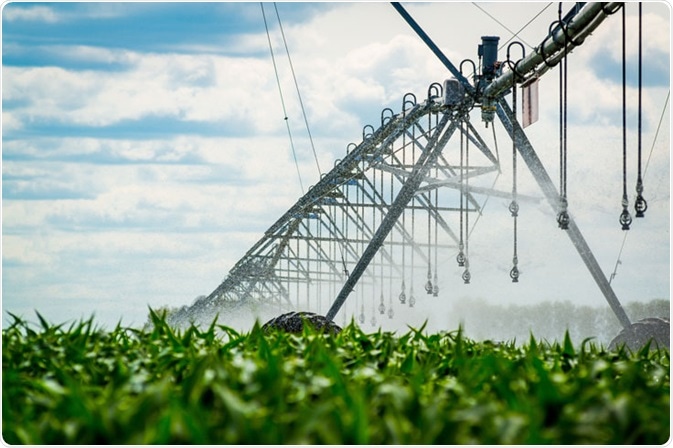
Image Credit: Avantes BV
This information enables farmers to identify whether irrigation is required, but there are limitations. The scale of use is restricted as the tensiometer is slow, requiring some time for the water to achieve equilibrium.
As far back as 1978, scientists have been interested in how soil moisture affects the visible spectrum. As spectroscopy methods improved, this eventually extended into the near- and mid-infrared2.
Hungarian researchers in 2014 aimed to calibrate spectral data designed to produce algorithms that would enable efficient, field-scale measurements of soil moisture content3.
The production of algorithms that will enable field-scale deployment of spectroscopy-based moisture measurements in the future firstly began with data collection in the laboratory.
Soil samples were collected around the region from orchards with different soil characteristics. These were initially kiln dried in the laboratory to consistent aridity.
Water was then slowly reintroduced, with spectra acquired for every 2.5 ml until the samples reached complete saturation. The wavelengths 1450-1460 nm and 1920-1930 nm were identified as the most sensitive for the quantification of soil moisture.
The AvaSpec-NIR256-1.7-EVO and AvaSpec-NIR256-2.5-HSC-EVO provide the sensitivity and range for this kind of application in the laboratory. Future developments in compact NIR spectrometers could eventually lead to the replacement of the tensiometer with handheld field instruments for the fast evaluation of moisture content. This could also be integrated with irrigation systems and to authenticate (ground truth) and calibrate airborne hyperspectral imaging technology3.
Soil Characterization
Soil is not a homogenous mixture, variations in minerals, organic matter, and particle size, as only a few examples, can alter an endless amount of soil characteristics4. The type of soil will determine everything from the crop types likely to prosper to irrigation schedules.
Twelve categories of soil are recognized by the US Department of Agriculture with sand at one end of the spectrum and clay at the other5. Each category has characteristics that can be predicted, for example, color.
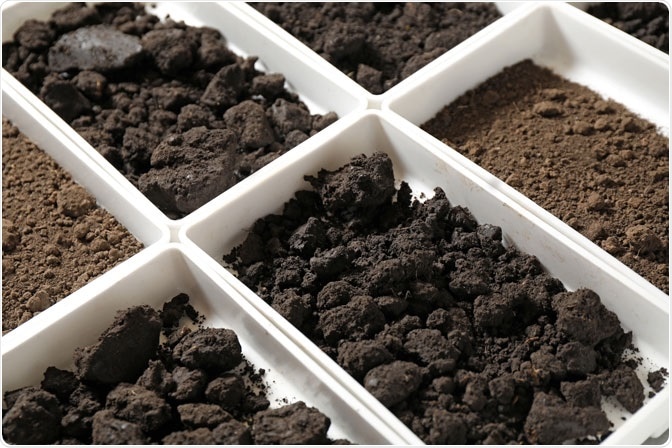
Soil samples for classification. Image Credit: Avantes BV
In fact, the most widespread technique for the determination of soil type depends on subjective (and error-prone) personal experience as a comparison against a specifically designed color chart from the Munsell Corporation2.
Alternative techniques for the classification of soil entail chemical procedures which may have negative effects on data analysis3. More advanced technical skills are required to perform these techniques which can also be time-consuming.
On the other hand, optical spectral sampling involves no harsh chemicals and little to no sample preparation, and multiple parameters can be investigated from the same spectral data.
UV/VIS/NIR spectroscopy was investigated by researchers in Hamadan, Iran, for the analysis of several soil parameters such as pH, color, moisture content, electrical conductivity, total nitrogen, exchangeable cations, and available organic carbon, along with the identification of minerals like titanium oxides, iron, magnesium, calcium, sodium, and potassium, to name only a few3.
The samples were collected, randomized, and kiln-dried before being ground and sieved. They were then separated into validation and calibration sets. From the group of validation samples, a full battery of chemometric data was acquired.
In the calibration set, over 24 broadband spectral scans were taken for each sample on average, where the spectrometer was used to detect the UV-VIS range from 200-1100 nm at a resolution of 1 nm.
Measurements in the NIR cover the 1000-2400 nm range. On the calibration set, the spectral analysis performed enabled a sequence of operations for statistical analysis based on least partial squares analysis (LPS-R) and principal component analysis (PCA). This allowed the spectral reflectance measurements to be correlated to observable soil characteristics.
The scientists concluded from the results that it was possible to effectively validate soil classification employing a fraction of available variables.
Bulk Density and Soil Compression
Soil compaction is the term to describe when spaces between particles of soil, which would normally contain water or air, are compressed. It causes oxygen deficiency, poor root development, and other deficiencies. These elements eventually decrease crop yields and quality. Compaction can be caused by natural processes or can be man-made, but is a critical agricultural and environmental issue1.
Repeated plowing to a uniform depth, extensive use of heavy machinery, and use by large animal populations are the common causes of soil compaction. Sustainable agricultural systems must focus on the management of soil compaction starting with the quantification of key parameters related to soil compaction.
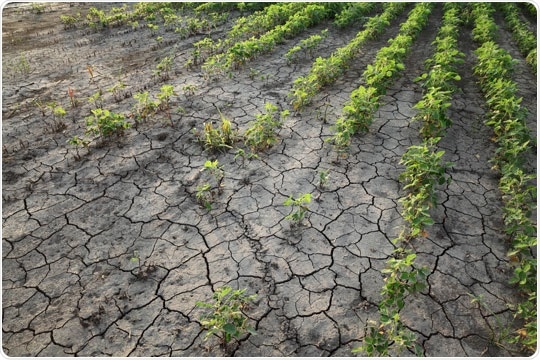
Effects of Soil Compaction. Image Credit: Avantes BV
Bulk soil density (BD) is represented by the ratio of volumetric moisture (Θv) content to gravimetric moisture (ω) (expressed as BD = Θv/ω). It is positively correlated with soil compaction, for example, the greater the extent of compaction, the higher the soil density1.
The penetrometer is the present technology for the measurement of soil compaction which is outdated. The penetrometer is designed to copy a growing plant root and includes a pressure gauge situated on top of a graduated driving shaft tipped with a wider 30-degree stainless steel cone.
In the journal Computers and Electronics in Agriculture, researchers in 2018 outlined a prototype measuring system that integrates a conventional penetrometer with a fiber-coupled NIRS sensor1.
The system functioned in situ to integrate the quantification of soil penetration resistance, frequency domain reflectometry to measure volumetric moisture content, and near-infrared diffuse reflectance for the quantification of gravimetric moisture content, to enable the determination of bulk density (BD) with one easy-to-control probe system1.
The unique design of the probe combined a penetrometer for the quantification of soil penetration resistance with a hollow shaft. At one end of the shaft, optical fibers were coupled to the 20-watt halogen lamp for input along with the AvaSpec-NIR256-2.5 spectrometer for NIR reflection data capture and output. On the other end, optical fibers were coupled to a sapphire window in the body of the shaft.
Volumetric moisture content (Θv) is quantified by time domain reflectometry measurements. These are performed by installing an electrode in the probe’s shaft in the form of a copper ring insulated from the body of the probe.
Hundreds of measurements were utilized to train an artificial neural network (ANN) to model the fusion of data. This generated promising results for the future production of bulk density solutions for efficient results in field applications1.
Avantes Meets the Challenge
The demand for efficient, reliable, and affordable data is not easily realized. A number of systems currently available are not adequate for field deployment. Operator errors and inconsistencies can lead to data collection being compromised.
The majority of research in designing all-in-one spectroscopy-based solutions appears to concentrate on eliminating risks caused by inconsistencies in deployment or user error2.
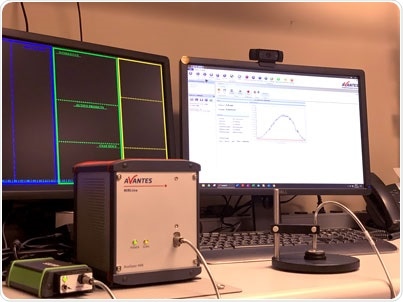
NIR Spectroscopy in the Laboratory. Image Credit: Avantes BV
Collaborating with a knowledgeable partner in spectroscopy can help the system design engineer to find solutions to an endless amount of field deployment challenges.
Avantes has 25 years of experience in directly collaborating with equipment manufacturers and researchers to produce systems that meet and exceed measurement demands. Discover the Avantes advantage and test drive an Avantes instrument with its exclusive demo program today.
References and Further Reading
- Al-Asadi, Raed A., and Abdul M. Mouazen. "A Prototype Measuring System of Soil Bulk Density with Combined Frequency Domain Reflectometry and Visible and near Infrared Spectroscopy." Computers and Electronics in Agriculture. Elsevier, 30 June 2018. Web. 19 Nov. 2019. https://www.sciencedirect.com/science/article/pii/S0168169917316277
- Han, Pengcheng, et al. “A Smartphone-Based Soil Color Sensor: For Soil Type Classification.” Computers and Electronics in Agriculture, vol. 123, 2016, pp. 232–241., doi:10.1016/j.compag.2016.02.024. https://www.sciencedirect.com/science/article/pii/S0168169916300618
- Monavar, Hosna Mohamdi. “34th International Conference on Food and Agricultural Engineering.” The Ires, Determination of Several Soil Properties Based on Ultra-Violet, Visible, and near-Infrared Reflectance Spectroscopy, 12 Mar. 2016, https://www.researchgate.net/publication/297322303_Determination_of_several_soil_properties_based_on_ultra-violet_visible_and_near-infrared_reflectance_spectroscopy “Soil.” Wikipedia, Wikimedia Foundation, en.wikipedia.org/wiki/Soil.
- “Soil.” Wikipedia, Wikimedia Foundation, https://en.wikipedia.org/wiki/Soil.
- USDA. “Natural Resources Conservation Service.” The Color of Soil | NRCS Soils, US Department of Agriculture, https://www.nrcs.usda.gov/
About Avantes BV
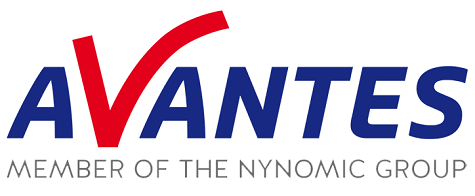 Avantes is a leading innovator in the development and application of miniatures spectrometers. Avantes continues to develop and introduce new instruments for fiber optic spectroscopy to meet our customer’s application needs.
Avantes is a leading innovator in the development and application of miniatures spectrometers. Avantes continues to develop and introduce new instruments for fiber optic spectroscopy to meet our customer’s application needs.
Avantes instruments and accessories are also deployed into a variety of OEM applications in a variety of industries in markets throughout the world.
With more than 18 years of experience in fiber optic spectroscopy and thousands of instruments in the field, Avantes is eager to help our customers find their Solutions in Spectroscopy®.
Techniques supported
- UV-VIS/NIR spectroscopy
- Process control
- Absorbance/transmittance/reflectance
- Laser-induced breakdown spectroscopy
- CIE color spectroscopy
- Portable spectrometers
- Fluorescence spectroscopy
- Custom applications
- lrradiance
- Raman spectroscopy
- OEM application development
Major products/services
Low-cost. high-resolution, miniature fiber optic spectrometers: System solutions and OEM instruments for applications from 185 nm to 2500 nm. Detector choices: PDA, CMOS, CCD, back-thinned CCD, and lnGaAs.
Optical benches with focal lengths of 45, SO or 75 mm; revolutionary new ultra-low straylight
optimized optical bench (ULS) and a new high sensitivity optical bench.
Other features
- 14 and 16 bit AID converters
- TE cooling
- multi-channel instrument configurations enabling simultaneous signal acquisition
- USB2 communication support for multiple instruments from a single computer
- 14 programmable digital I/O ports
Standard application solutions
- lrradiance and LED measurements
- gemology
- hemometric analysis
- thin-film measurement
- color
- fluorescence
- laser-induced breakdown spectroscopy (LIBS)
- Raman spectroscopy
- process control
Light sources
- Tungsten-halogen
- Deuterium
- LED
- Xenon calibration sources for wavelength and irradiance
Sponsored Content Policy: News-Medical.net publishes articles and related content that may be derived from sources where we have existing commercial relationships, provided such content adds value to the core editorial ethos of News-Medical.Net which is to educate and inform site visitors interested in medical research, science, medical devices and treatments.